
Atlas F1 Technical Writer
Sauber became the second Formula One team to officially launch their new car for the 2004 season this week. Unlike Williams a week earlier, the Swiss squad opted for a more traditional design that to many resembles that of Ferrari's F2003-GA. Atlas F1's Technical Writer Craig Scarborough looks closer to the new Sauber C23
History
Going into 2004, although the impressive wind tunnel is complete it still requires testing and calibration and won't be in use for production testing until spring. In the meantime, the C23 needed to be designed with the Emmen tunnel and the team's resources would be unable to use alternative tunnels or find a design comfortable with yaw at the Emmen facility. Finding a suitable aerodynamic solution that both would be faster than the old design and proven would require insight form elsewhere.
Equally, going into the one engine formula would require Ferrari's 2004 engine designed specifically for the rules, matching this engine to Sauber's own gearbox design could be considered a risk to reliability.
Sauber have been a staunchly autonomous team, proud of the ability to source non-tobacco sponsors, develop their own unique car, and keep an independent working relationship with Ferrari. But, Sauber are also pragmatic and commercially minded, even their wind tunnel has been funded on the basis it would be viable purely as a commercial tunnel, that is without Sauber's sponsors paying for their use of it. So with the technical issues facing the team with aerodynamics and gearbox, they have made use of their relationship with Ferrari to buy know-how and parts to ensure their 2004 challenge is a success. As a result, the C23 adopts Ferrari's 2004 (054) engine and 2003 gearbox, and has taken their aerodynamic concept too.
While the aerodynamics dictate the shape of the monocoque, this should not be confused with the structure of the monocoque, which is still under the control of the designer Willy Rampf. Hence the detail design of the structure and mechanical parts need to be designed by Sauber. The result is a totally different car to the Ferrari. While at first this seems to be a simple F2003-GA copy, the facts about how Sauber have engineered this car go deeper than the visual similarities appear.
Aerodynamics
Overall the concept can be summed up as the same as the Ferrari F2003-GA, being a long single-keel high-nose concept, leading back to slim sloping sidepods, with the GA's undercut front face. Finally ending with a slim engine gearbox cover. With this layout pushing the engine backwards, and with the shorter gearbox also pushing weight backwards, Ferrari made up this shift with ballast at the front of the car.
Again bargeboards are carried over from the C22 and lead towards one of the few visual differences between the cars, being the angular section of monocoque to the side of the driver that form part of the side impact protection. Sauber have openly admitted stiffness and impact resistance were aims of the design and the bigger structure suggests that Sauber are not as advanced as Ferrari in this area. Otherwise the shape of the monocoque including the undercut of the chassis where the raised nose meets the splitter are consistent between the cars. However the splitter itself is a carry over shape from the C22 with a thin forward section and plough shape forming the transition between the lower splitter and the sidepods. This area housed ballast on the C22 and although Sauber announced they have ballast to play with this year, there is not the double-skinned ballast filled version used by Ferrari or Williams. Suggesting that, although the shift in the masses rearwards has been an aerodynamic feature, the need to push ballast forwards has not been required.
In summary, a Ferrari shape has been adopted in the keel area and the tail, with the sidepods being developed from Ferrari-like versions already running last year. But the splitter and under-floor are very much Sauber influenced, proving the car is not all Maranello's thinking.
Structures
Aside from the aerodynamic shape, Sauber reverting back to the single keel is probably a bigger shock when looking at the C23, having made twin keels work aerodynamically and structurally for several years. Recent gains made in front wing design push the downforce creating wing sections outboard lessens the advantage of the keel set-up for a conventional nose\bargeboard set-up. With stiffness and weight loss a priority for the team the keels were a compromise they could now afford to lose. A single keel mounting both wishbones no longer has to bear the weight of material to take the lateral load through a "U" shape from wishbone to wishbone.
Engine\Gearbox and Mechanicals
Sauber have run Ferrari engines for years, but have always preferred to design their own gearbox and casing. Despite less accurate reporting of this fact in other publications and TV sources, insisting the Sauber had previously used Ferrari's complete rear end and suspension. Only for 2004 have Sauber taken Ferrari's titanium cased gearbox. From the shaping at the rear of the engine cover its' clear the gearbox is complete with its damper and torsion bar layout.
Sauber's use of the German Sachs dampers matches Ferrari, but Ferrari used a different format of damper in 2003, using a radial damper over the conventional linear type. It is known the Ferrari gearbox had the option to run either format of damper, so it's not clear which type Sauber will run.
On the engine side Sauber have Petronas engineering, a subsidiary of Sauber funded by the Malaysian Oil Company, headed by Osama Goto. Keeping in with the independent philosophy Petronas have engineered the installation of the Ferrari engine, which covers cooling, airbox and exhausts design, all using baseline technical data provided by Ferrari. It would appear this strategy is carried over. Electronics development is done via Magnetti-Marelli, again an independent development programme, albeit with a partner shared with Ferrari.
With two official launches for the 2004 season there have been two surprises: Williams adopted a radical nose and twin keels, and now Sauber have gone the opposite way and discarded their design and twin keels, instead opting to follow Ferrari's leading in many areas of the car. Supporting the Ferrari conspiracy theorists is the official supply of 2004-spec engines and the 2003 gearbox. If we read between the lines and examine the car in detail, the Sauber still retains some resemblances to its Sauber forebear and diversions from the Ferrari concept, in keeping with Peter Sauber's independent philosophy.
 2003 was a poor year for Sauber; the C22 was a logical progression from the relatively successful previous car and with Ferrari's newer engine the package looked promising. However the car's aerodynamics were developed in the Emmen wind tunnel, which was both old and underequipped: almost uniquely in F1, the Emmen tunnel did not have a turntable to rotate the car (Yaw), hence Sauber's aerodynamic map of the car over all attitudes was incomplete. This flaw saw the car's performance on track at odds with the tunnels results. They spent the first half of the season languishing towards the back of the midfield. Under the direction of Seamus Mullarkey the team decided to research the car's behaviour at a tunnel that could provide a yaw attitude. After a short spell at the Lola tunnel in the UK, with a collection of new body parts the team made the breakthrough and the new bodywork seen around Monza was the result of these sessions. Gone was Sauber's trademark boxy undercut sidepods and in were sloping sidepods with the vogue winglets and long low flip up. This set-up brought the team greater pace and finally success at Indy with two strong points finishes, albeit aided by the Bridgestone wet tyres, turning around their position in the championship at the last minute.
2003 was a poor year for Sauber; the C22 was a logical progression from the relatively successful previous car and with Ferrari's newer engine the package looked promising. However the car's aerodynamics were developed in the Emmen wind tunnel, which was both old and underequipped: almost uniquely in F1, the Emmen tunnel did not have a turntable to rotate the car (Yaw), hence Sauber's aerodynamic map of the car over all attitudes was incomplete. This flaw saw the car's performance on track at odds with the tunnels results. They spent the first half of the season languishing towards the back of the midfield. Under the direction of Seamus Mullarkey the team decided to research the car's behaviour at a tunnel that could provide a yaw attitude. After a short spell at the Lola tunnel in the UK, with a collection of new body parts the team made the breakthrough and the new bodywork seen around Monza was the result of these sessions. Gone was Sauber's trademark boxy undercut sidepods and in were sloping sidepods with the vogue winglets and long low flip up. This set-up brought the team greater pace and finally success at Indy with two strong points finishes, albeit aided by the Bridgestone wet tyres, turning around their position in the championship at the last minute.
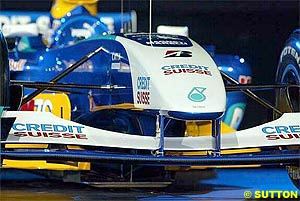 Even with Sauber using a lesser-equipped commercial wind tunnel they have always produced an efficient and unique aerodynamic concept. Their pioneering adoption of twin keels, slim sidepods and curved front wings have seen them confident in their resources. Last year this efficiency ran out and the new car saw the team looking to their technical partners for assistance. Quite how far Ferrari have gone in giving Sauber dimensioned drawings of the external surfaces is not public. But, despite many people commenting on the car being a carbon copy, the detail execution of the concept diverges from Ferrari's in many areas, being driven by both the new rules and Sauber's take on the solution.
Even with Sauber using a lesser-equipped commercial wind tunnel they have always produced an efficient and unique aerodynamic concept. Their pioneering adoption of twin keels, slim sidepods and curved front wings have seen them confident in their resources. Last year this efficiency ran out and the new car saw the team looking to their technical partners for assistance. Quite how far Ferrari have gone in giving Sauber dimensioned drawings of the external surfaces is not public. But, despite many people commenting on the car being a carbon copy, the detail execution of the concept diverges from Ferrari's in many areas, being driven by both the new rules and Sauber's take on the solution.
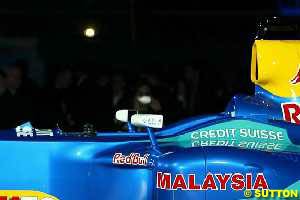 Sauber's previous wedge-shaped nose tip has been eschewed for a more rounded shape with less droop over the front wing than the Ferrari. It's probably best not to read too much into the front wing and endplates which may not be definitive for 2004, but it is clear that the twin pylons mounting the wing are very close together, making the nose tip appear wider than perhaps it is.
Sauber's previous wedge-shaped nose tip has been eschewed for a more rounded shape with less droop over the front wing than the Ferrari. It's probably best not to read too much into the front wing and endplates which may not be definitive for 2004, but it is clear that the twin pylons mounting the wing are very close together, making the nose tip appear wider than perhaps it is.
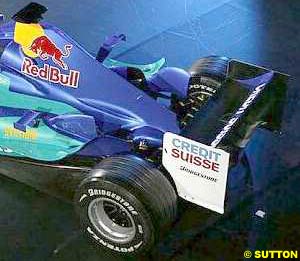 The engine cover and rear wing endplate are now enlarged to meet the new regulations and Sauber has slimmed the cross section of the airbox cover more then the F2003-GA, resulting in the airbox bulging out of the rear section of the tail. As is always the case, the diffuser was obscured for the launch but the more rounded and lower outer tunnels were apparent.
The engine cover and rear wing endplate are now enlarged to meet the new regulations and Sauber has slimmed the cross section of the airbox cover more then the F2003-GA, resulting in the airbox bulging out of the rear section of the tail. As is always the case, the diffuser was obscured for the launch but the more rounded and lower outer tunnels were apparent.
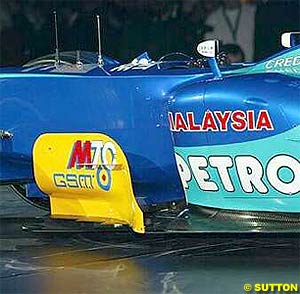 While keeping the monocoque from the dash bulkhead to the front bulkhead highly raised, in keeping with the Ferrari concept the nose tip is not as drooped, this straighter nose cone creates an easier to accept load from the crash test and hence allows the component to be lighter. Further back along the car the smaller sidepods were an aerodynamic requirement, then the added detail of the undercut on the sidepods further restricts space for the structural designer to house side impact protection. It is these structures that are yet to pass the FIA tests. Lastly, a smaller fuel tank and redesigned rear bulkhead to accommodate the newer Ferrari engine have been demanded for the C23.
While keeping the monocoque from the dash bulkhead to the front bulkhead highly raised, in keeping with the Ferrari concept the nose tip is not as drooped, this straighter nose cone creates an easier to accept load from the crash test and hence allows the component to be lighter. Further back along the car the smaller sidepods were an aerodynamic requirement, then the added detail of the undercut on the sidepods further restricts space for the structural designer to house side impact protection. It is these structures that are yet to pass the FIA tests. Lastly, a smaller fuel tank and redesigned rear bulkhead to accommodate the newer Ferrari engine have been demanded for the C23.
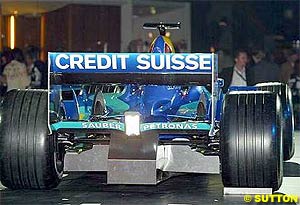 Also Sauber's suspension geometry appears to reflect a different philosophy, requiring different wishbones length and upright design. This is apparent by the shorter length of the upper rear wishbone, as location of the outboard pivot on the wishbone is visible outside of the wheel and brake duct. Currently it is impossible to speculate on the design inside the front of the car for steering and suspension. Sauber have already developed a power steering system and use their own format of rockers to operate the dampers, torsion bars and roll bars. But considering the engineering of the chassis is kept under Sauber's control, it probably follows that the design is developed from the C22 and not the F2003-GA. Barring the geometry change from twin keels to a single keel affecting the lower wishbone.
Also Sauber's suspension geometry appears to reflect a different philosophy, requiring different wishbones length and upright design. This is apparent by the shorter length of the upper rear wishbone, as location of the outboard pivot on the wishbone is visible outside of the wheel and brake duct. Currently it is impossible to speculate on the design inside the front of the car for steering and suspension. Sauber have already developed a power steering system and use their own format of rockers to operate the dampers, torsion bars and roll bars. But considering the engineering of the chassis is kept under Sauber's control, it probably follows that the design is developed from the C22 and not the F2003-GA. Barring the geometry change from twin keels to a single keel affecting the lower wishbone.
Please Contact Us for permission to republish this or any other material from Atlas F1.
|
Volume 10, Issue 2
Articles
Massa Transit
Mister Clean
Technical Analysis: Sauber C23
2004 Countdown: Facts & Stats
Columns
The Sauber Trivia Quiz
Rear View Mirror
Bookworm Critique
On the Road
Elsewhere in Racing
> Homepage |